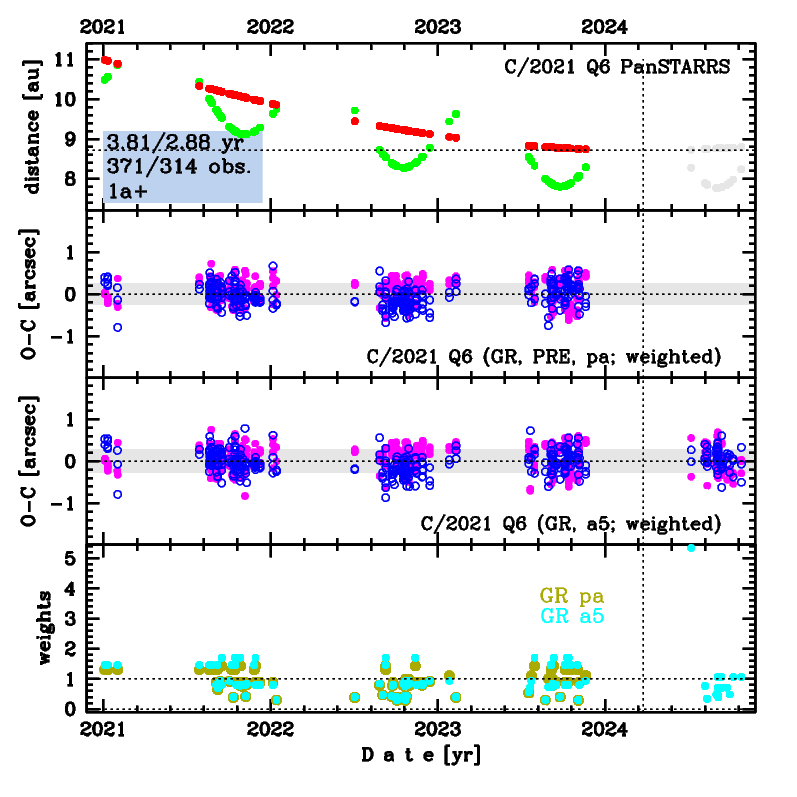C/2021 Q6 PanSTARRS
more info
Comet C/2021 Q6 was discovered on 22 August 2021 with the Pan-STARRS 1 telescope (Haleakala), that is two years and seven months before its perihelion passage.
Comet had its closest approach to the Earth on 2 September 2024 (7.76 au), about half a year after its perihelion passage.
Preferred GR solution given here is based on data span over 3.81 yr in a range of heliocentric distances: 10.99 au – 8.71 au (perihelion) – 8.80 au.
This Oort spike comet suffers tiny planetary perturbations during its passage through the planetary system that likely lead to escape this comet from the solar system on a marginally hyperbolic orbit.
Comet had its closest approach to the Earth on 2 September 2024 (7.76 au), about half a year after its perihelion passage.
Preferred GR solution given here is based on data span over 3.81 yr in a range of heliocentric distances: 10.99 au – 8.71 au (perihelion) – 8.80 au.
This Oort spike comet suffers tiny planetary perturbations during its passage through the planetary system that likely lead to escape this comet from the solar system on a marginally hyperbolic orbit.
| solution description | ||
|---|---|---|
| number of observations | 371 | |
| data interval | 2021 01 02 – 2024 10 25 | |
| data type | perihelion within the observation arc (FULL) | |
| data arc selection | entire data set (STD) | |
| range of heliocentric distances | 10.99 au – 8.71 au (perihelion) – 8.8 au | |
| detectability of NG effects in the comet's motion | NG effects not determinable | |
| type of model of motion | GR - gravitational orbit | |
| data weighting | YES | |
| number of residuals | 733 | |
| RMS [arcseconds] | 0.28 | |
| orbit quality class | 1a+ | |
| next orbit statistics, both Galactic and stellar perturbations were taken into account | ||
|---|---|---|
| no. of returning VCs in the swarm | 0 | |
| no. of escaping VCs in the swarm | 5001 | * |
| no. of hyperbolas among escaping VCs in the swarm | 0 | |
| next reciprocal semi-major axis [10-6 au-1] | 3.35 – 3.99 – 4.67 | |
| next perihelion distance [au] | 74.31 – 74.9 – 75.47 | |
| next aphelion distance [103 au] | 430 – 500 – 600 | |
| synchronous stop epoch [Myr] | 3.2 | S |
| percentage of VCs with qnext > 20 | 100 | |
| next_g orbit statistics, here only the Galactic tide has been included | ||
|---|---|---|
| no. of returning VCs in the swarm | 0 | |
| no. of escaping VCs in the swarm | 5001 | * |
| no. of hyperbolas among escaping VCs in the swarm | 47 | |
| next reciprocal semi-major axis [10-6 au-1] | 0.55 – 1.22 – 1.92 | |
| next perihelion distance [au] | 33.2 – 33.8 – 34.5 | |
| next aphelion distance [103 au] | 1000 – 1600 – 3500 | |
| synchronous stop epoch [Myr] | 3.09 | S |
| percentage of VCs with qnext > 20 | 100 | |
